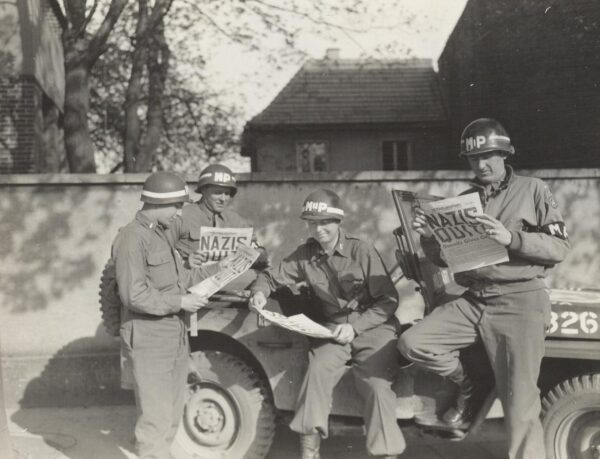
MPs stationed in Europe read about Nazi Germany’s surrender.
May 8, 1945: Victory in Europe Day, or V-E Day, marks Nazi Germany’s unconditional surrender to the Allied Nations during the final months of World War II.
The last days of World War II in Europe
As the Soviets continued their advance through Eastern Europe, and long after Italy had capitulated to the south, U.S. and Allied Forces put boots on the ground in Western Europe on June 6, 1944, when they conducted the largest amphibious landing on the beaches of Normandy, France.
Long exhausted from nearly five years of constant fighting, and facing a determined adversary on all sides, Nazi Germany was unable to withstand the onslaught approaching its borders. A failed Nazi counteroffensive in late 1944, now known as the Battle of the Bulge, all but assured that the Allies would be imminently victorious.
On April 30, 1945, as Western armies encircled Berlin and the Soviet Red Army stormed the capital, these predictions proved true when Adolf Hitler committed suicide in a dark, cramped bunker.
Hitler’s successor, Karl Dönitz, authorized the unconditional surrender of Germany to the Allies shortly thereafter, and Nazi Germany ceased to exist.
Legacy of Victory in Europe Day
Victory in Europe Day was a moment of joy and relief for millions of people who had suffered under the Nazi Regime, as well as a moment of gratitude and respect for those who had fought and sacrificed their lives to restore democracy and a better future for humanity.
But World War II had not reached its end.
While people in the United States and around the world celebrated Nazi Germany’s defeat, the war still raged in the Pacific Theater. It would be nearly two months before U.S. Forces achieved a costly victory at the Battle of Okinawa against Imperial Japan, and still longer before Victory over Japan would finally end the war for good.












